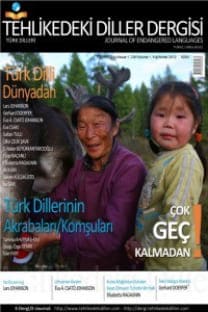TÜRKİYE NOGAYLARI ÜZERİNE GÖZLEMLER VE TESPİTLER (MESQÚW’DAN KELGENLER)
Türkiye’de yaşayan Nogayların bir bölümü Tuz Gölü civarındaki köylerde yaşamaktadır. Bu köylerin kurucuları da olan Nogayların bir kısmı, 18. yüzyılda gerçekleşen Osmanlı-Rus Savaşı (1768-1774) etkisi ile diğer bir kısmı ise 19. yüzyılın ikinci yarısında (1859-1961) Kırım Hanlığı’nın dağılması sonucu oluşan yeni siyasi gücün baskısı ile Osmanlı topraklarına göç etmişler. Günümüzde bu köylerde torunları ve torunlarının çocukları yaşıyor. Hepsi de atalarının çaresizlikten göç ettiğini düşünüyor ve ata yurtlarını, tarihlerini, kültürlerini onların kendilerine anlattıkları kadarı ile biliyorlar.Bu makalede ‛Göç Nogayları’nın torunlarının anlatımlarından hareketle göç öyküleri, Tuz Gölü Nogay köyleri, Nogayların kültürlerine ve dillerine karşı tutum ve davranışları ele alınıyor. Ayrıca genç Nogayların, kültürlerini hem daha yakından tanıma hem de yaşatmaya çalışma çabalarına da değiniliyor
Anahtar Kelimeler:
Nogayca, Türkiye Nogayları, Sabantoyu, Kırkkuyu, Akin, Şekerköy, Doğankaya, Boğazören, Ağılbaşı, Seyitahmetli
SOME OBSERVATIONS AND EVALUATIONS ON THE NOGHAYS IN TURKEY
Part of the Noghays in Turkey live in the villages around Salt Lake. Some of the Noghays, who were the founders of these villages, moved to Ottoman lands because of the political effects of Ottoman and Russian war during 18th century and others moved to Ottoman lands because of the political effects of Crimean Khanate’s resolution during the middle of the 19th century. At present, those who live in these villages are the grand children or the grand grand children of these people. They all think their ancestors moved because they had no other choice. Their knowledge of their homeland, history, and culture is solely based on what they were told by the elderly.This article is about the stories on Noghays’ migrations as told by grand children, Salt Lake Noghay villages and their attitudes towards their culture and language. It also highlights how willing the younger Noghays are to take a closer look and learn about their culture, and also shows their efforts to keep it alive.
Keywords:
Noghay, Noghays in Turkey, Sabantoy, Kırkkuyu, Akin, Şekerköy, Doğankaya, Boğazören, Ağılbaşı, Seyitahmetli,
- Başlangıç: 2012
- Yayıncı: Ülkü ÇELİK ŞAVK
Sayıdaki Diğer Makaleler
NOGAY ADI VE NOGAYLARIN KÖKENİ ÜZERİNE
Türkiye’deki Kırım Tatar ve Nogay Köy Yerleşimleri
TEHLİKEDEKİ TÜRK DİLLERİ: GAGAUZCA ÖRNEĞİ
KORECEDEKİ BAZI ALTAYCA ŞAMANİST KANITLAR
KONUK EDİTÖRÜN NOTU NOGAY DOSYASI
HALAÇLARDAN MOLLA NASREDDİN FIKRALARI
